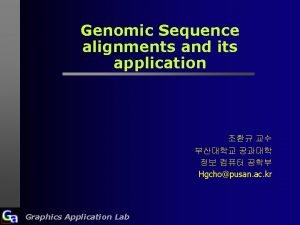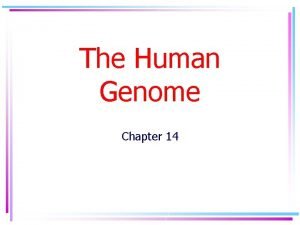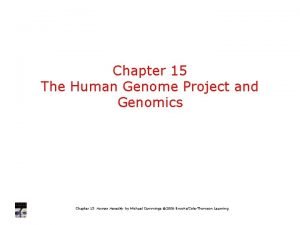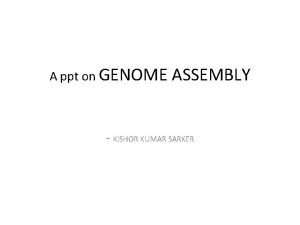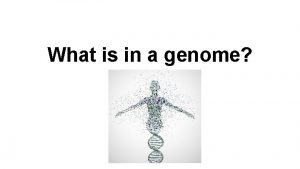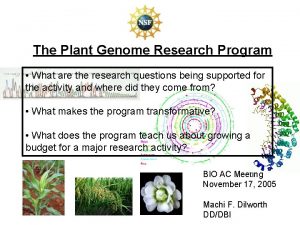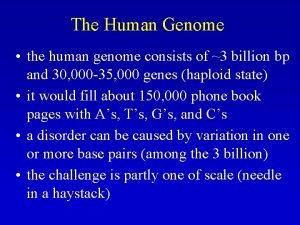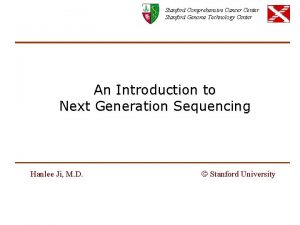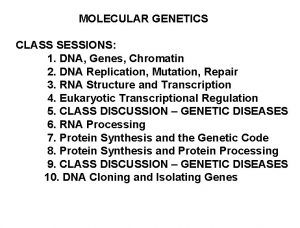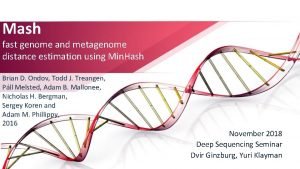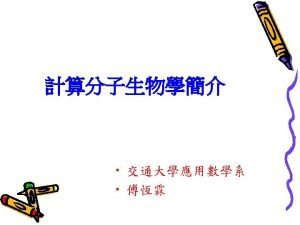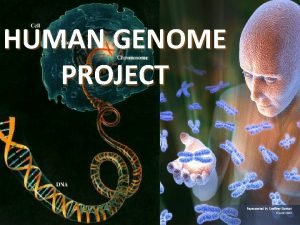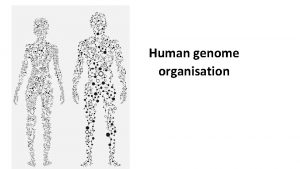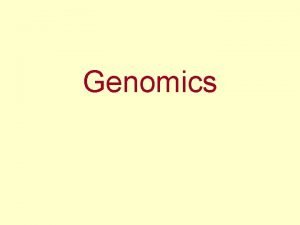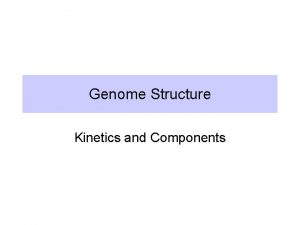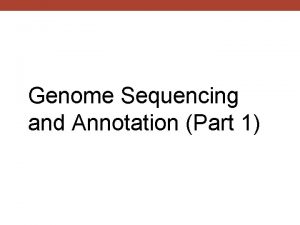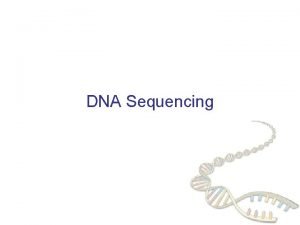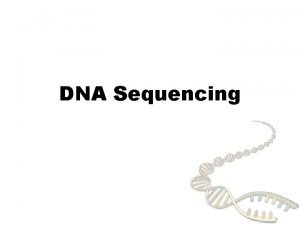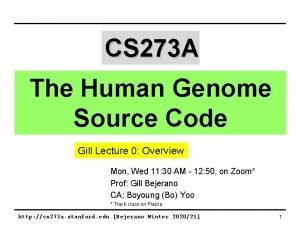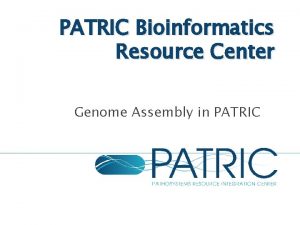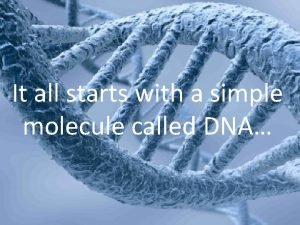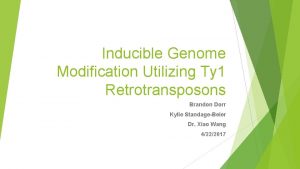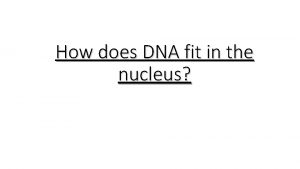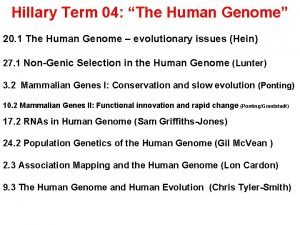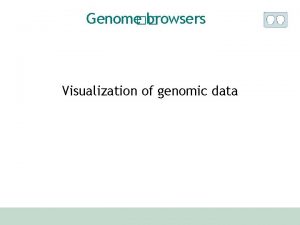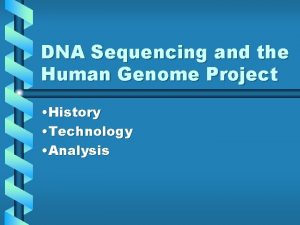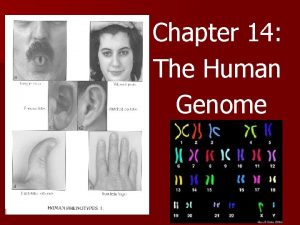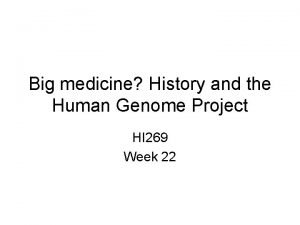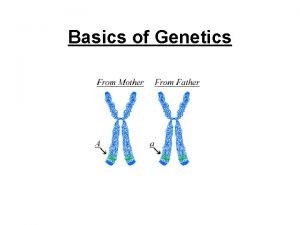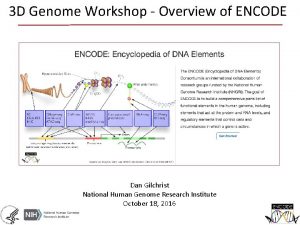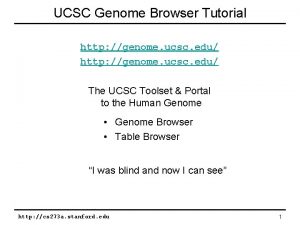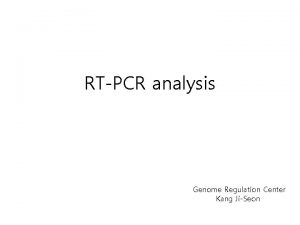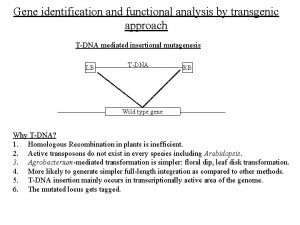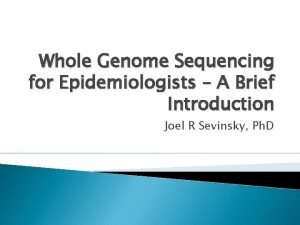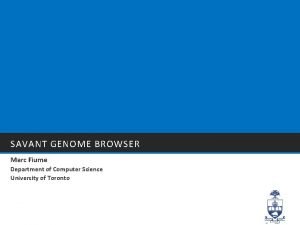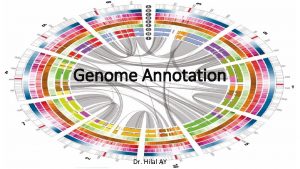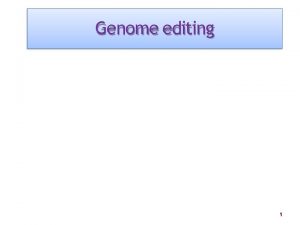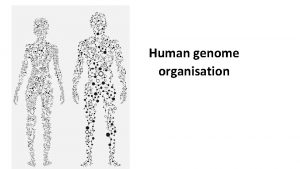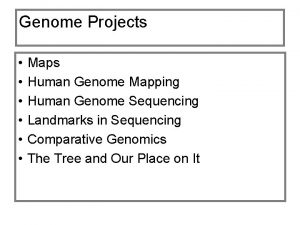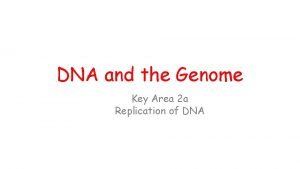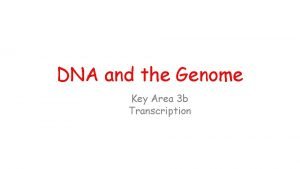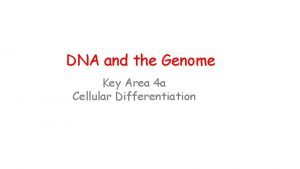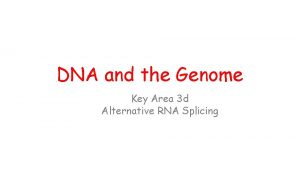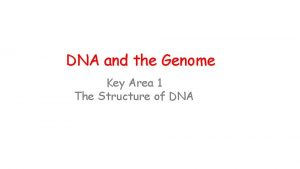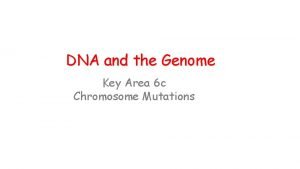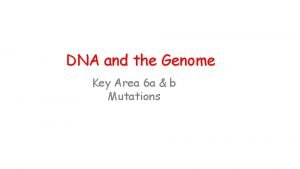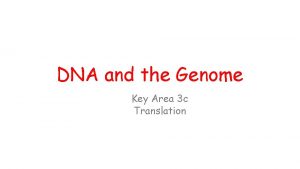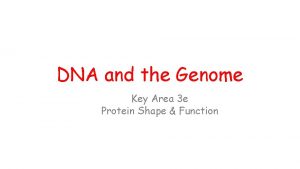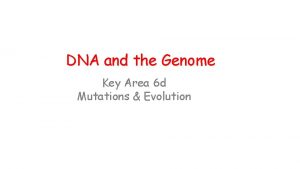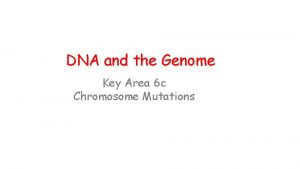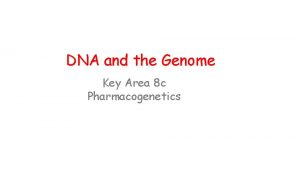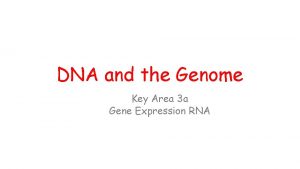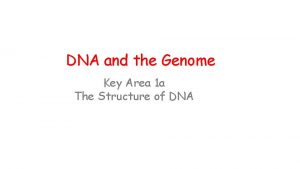DNA and the Genome Key Area 7 a










































- Slides: 42

DNA and the Genome Key Area 7 a & b Evolution & Selection

Learning Intentions By the end of this topic you should be able to: (a) Evolution Explain what ‘genomic variations’ are Define ‘evolution’ (b) Selection & Gene Transfer Describe how ‘vertical gene transfer’ can take place Explain why vertical gene transfer can be referred to as inheritance Describe how ‘horizontal gene transfer’ can take place Explain the implication for evolution of prokaryotes carrying out horizontal gene transfer Describe how viruses and prokaryotes can transfer DNA sequences horizontally into the genomes of eukaryotes Explain the significance of viruses and prokaryotes transferring DNA sequences horizontally into the genomes of eukaryotes

Learning Intentions By the end of this topic you should be able to: (b) Selection & Gene Transfer cont Define ‘natural selection’ Give 2 examples of natural selection Define ‘sexual selection’ Give 2 examples of sexual selection Explain what happens as a result of ‘stabilising selection’ Explain what happens as a result of ‘directional selection’ Explain what happens as a result of ‘disruptive selection’

Evolution

Evolution is the changes in organisms over generations as a result of genomic variations. It is: a gradual change in the characteristics of a population of organisms…. over successive generations

Evolution These variations take the form of changes in the frequencies of alleles of genes Evolution accounts for the origin of existing species from ancestors that lived long ago who were often very different from present day species. It involves the processes of inheritance, selection, drift and speciation

Watch the stated clearly “Evolution” clip (9 min) at home

Natural Selection

Natural Selection is the: • Non-random increase in the frequency of DNA sequences that increase survival • Non-random reduction in the frequency of deleterious DNA sequences

Natural Selection Charles Darwin and Alfred Wallace came up with the idea that the main factor producing evolutionary change is natural selection In their paper, On the Origin of Species, they say:

Members of a species show variation in all characteristics and much of this is inherited

Organisms produce more offspring than the environment can support A struggle for existence follows and many offspring die before reaching reproductive age due to lack of food, overcrowding, lack of disease

Those offspring better adapted to the environment have a better chance of surviving, reproducing and passing on the favourable characteristics (alleles) to their offspring Those offspring less well adapted to the immediate environment die and fail to pass on the less favourable characteristics (alleles)

This process is repeated generation after generation. The organisms best suited to the environment are naturally selected for and eventually predominate in the population. The organisms less suited to the environment are naturally selected against. This process is called survival of the fittest

Click on the following link and select the Natural Selection video (10 min) Natural Selection

Selection Against Deleterious Sequences Sometimes a new variation occurs in a species which results in an inferior characteristic. According to natural selection this individual will have less than the average number of offspring The result of this is that the deleterious genetic sequence will be passed onto fewer successive generations and may be eliminated from the population in time This is a non-random reduction in the genetic frequency and if the sequence is lethal it will disappear more quickly

Evolution of Resistant Insects Human interaction can also change what may be the natural pathway of evolution DDT is a chemical that was widely used as an insecticide to control the likes of mosquitos (which carry malaria) and pests (which destroy crops)

A mutant resistant to pesticide was present in the first generation but had no selective advantage After application of pesticide, most non-mutant pests are killed With each application, the mutant has a selective advantage and its numbers increase in the population until it becomes dominant in the population

Stabilising, Directional and Disruptive Selection

Selecting a Quantitative Trait Quantitative data is data that can be measured in units, such as height or seed mass Polygenic traits (controlled by more than one gene) are quantitative Natural selection can affect the frequency of a quantitative trait within a large population When the data for large populations are graphed it produces a bell -shaped normal distribution curve

Increasing number of individuals Most organisms in the population are in the middle (average) part of the graph Increasing value of inherited characteristic e. g. height (m) There will be fewer and fewer organisms as you move to both extremes of the curve

Stabilising Selection In stabilising selection, an average phenotype is selected for and extremes of the phenotype range are selected against This type of selection favours the intermediate organisms in the population and puts pressure on the extremes The number of individuals remain fairly constant but there is a reduction in the diversity

Mean Increasing number of individuals Mean remains unchanged Increasing value of inherited characteristic Birth mass in human babies is an example of this – almost always in the 3 – 4 kg range • Lower mass babies are at risk of infection and fatal disease • Higher mass babies encounter problems at birth passing through the mothers pelvis

Directional Selection In directional selection, one extreme of the phenotype range is selected for. This selection mostly occurs during environmental change and favours one of the extremes in the population curve There is a progressive shift in the populations mean (increase or decrease)

New Mean Increasing number of individuals Mean Increasing value of inherited characteristic For example, during the ice age the average body size of black bears increased as they were better able to maintain body temper

Disruptive Selection In disruptive selection, two or more phenotypes are selected for Both extremes are favoured over the intermediates The population is split into 2 distinct groups, both with their own mean values It occurs in nature if 2 different habitats or types of resources become available

Mean Increasing number of individuals Separate means emerge Increasing value of inherited characteristic Human interaction, such as the selective breeding of dogs to produce very large and very small varieties of dog, is another example of disruptive selection

Directional Selection Stabilising Selection Disruptive Selection

Look at the following animation for examples of stabilising, directional and disruptive selection Selection

Inheritance Genetic material can be inherited in one of two ways: Vertical Gene Transfer – genes are transferred from parent to offspring as a result of sexual or asexual reproduction Horizontal Gene Transfer – genes are transferred between individuals in the same generation

Vertical transfer of genetic material Genes can be transferred from parents down to their offspring by: (a) Sexual reproduction (b) Asexual reproduction

Sexual Reproduction This involves two parents who differ from one another genetically. Brown wavy hair Blue eyes Offspring inherit different combinations of genes from each parent. This information is usually displayed in a family tree Dimples Straight red hair Brown eyes No dimples

Asexual reproduction Is reproduction from a single parent and it produces offspring who are genetically identical to the parent This type of reproduction occurs in both prokaryotes and eukaryotes

Horizontal Transfer - Prokaryotes In prokaryotes (eg bacteria) who reproduce asexually, genetic material can also be transferred horizontally – between individuals in the same generation:

Horizontal Transfer

Horizontal Transfer

Horizontal Transfer

Rapid Evolutionary Change

Rapid Evolutionary Change in Prokaryotes During the early stages of prokaryotic evolution, it was believed there was a high incidence of horizontal gene transfer (HGT) This led to a rapid spread of new genetic sequences and the build up of larger genomes, leading to rapid evolutionary change One reason for this was that it is much faster to obtain new genes via horizontal gene transfer rather than waiting for natural evolution

Risks Associated with HGT This method of evolutionary change does carry its risks as there is no guarantee the new genes will provide an advantage: 1. New genes may actually be useless or harmful 2. New genes have not been tested and tried by parents

Tree of Life Over time, the role of vertical inheritance increased in importance and direct lineages began to emerge Each lineage had its own sets of specific genes which gave rise to the tree of life

Bacteria Archaea Universal Ancestor Eukaryote
 Genome-to-genome distance calculator
Genome-to-genome distance calculator Sickle cell karyotype
Sickle cell karyotype Chapter 15
Chapter 15 Coding dna and non coding dna
Coding dna and non coding dna Function of dna polymerase 3
Function of dna polymerase 3 Bioflix activity dna replication dna replication diagram
Bioflix activity dna replication dna replication diagram What are the enzymes involved in dna replication
What are the enzymes involved in dna replication Chapter 11 dna and genes
Chapter 11 dna and genes Sequence assembly ppt
Sequence assembly ppt Business model canvas examples
Business model canvas examples Contoh bisnis model canvas makanan pdf
Contoh bisnis model canvas makanan pdf Dna structure and replication packet answer key
Dna structure and replication packet answer key Genomics
Genomics Plant genome research program
Plant genome research program Euphenics
Euphenics Stanford
Stanford Human genome size
Human genome size Min-hash
Min-hash Human genome size
Human genome size Bacterial artificial chromosome slideshare
Bacterial artificial chromosome slideshare Strs and vntrs
Strs and vntrs Perpartes
Perpartes Repeated sequences
Repeated sequences Shotgun sequencing
Shotgun sequencing Hierarchical shotgun sequencing vs whole genome
Hierarchical shotgun sequencing vs whole genome Dna
Dna Human genome project source code
Human genome project source code Patric genome
Patric genome National human genome research institute
National human genome research institute Genome modification ustaz auni
Genome modification ustaz auni National human genome research institute
National human genome research institute Sequencing human genome
Sequencing human genome Genome klick
Genome klick History of sequencing
History of sequencing Chapter 14 the human genome
Chapter 14 the human genome Human genome project
Human genome project Turner syndrome
Turner syndrome Encode
Encode Genome.ucsc.edu tutorial
Genome.ucsc.edu tutorial Genome
Genome Genome identification
Genome identification Genome sequencing
Genome sequencing Marc fiume
Marc fiume
